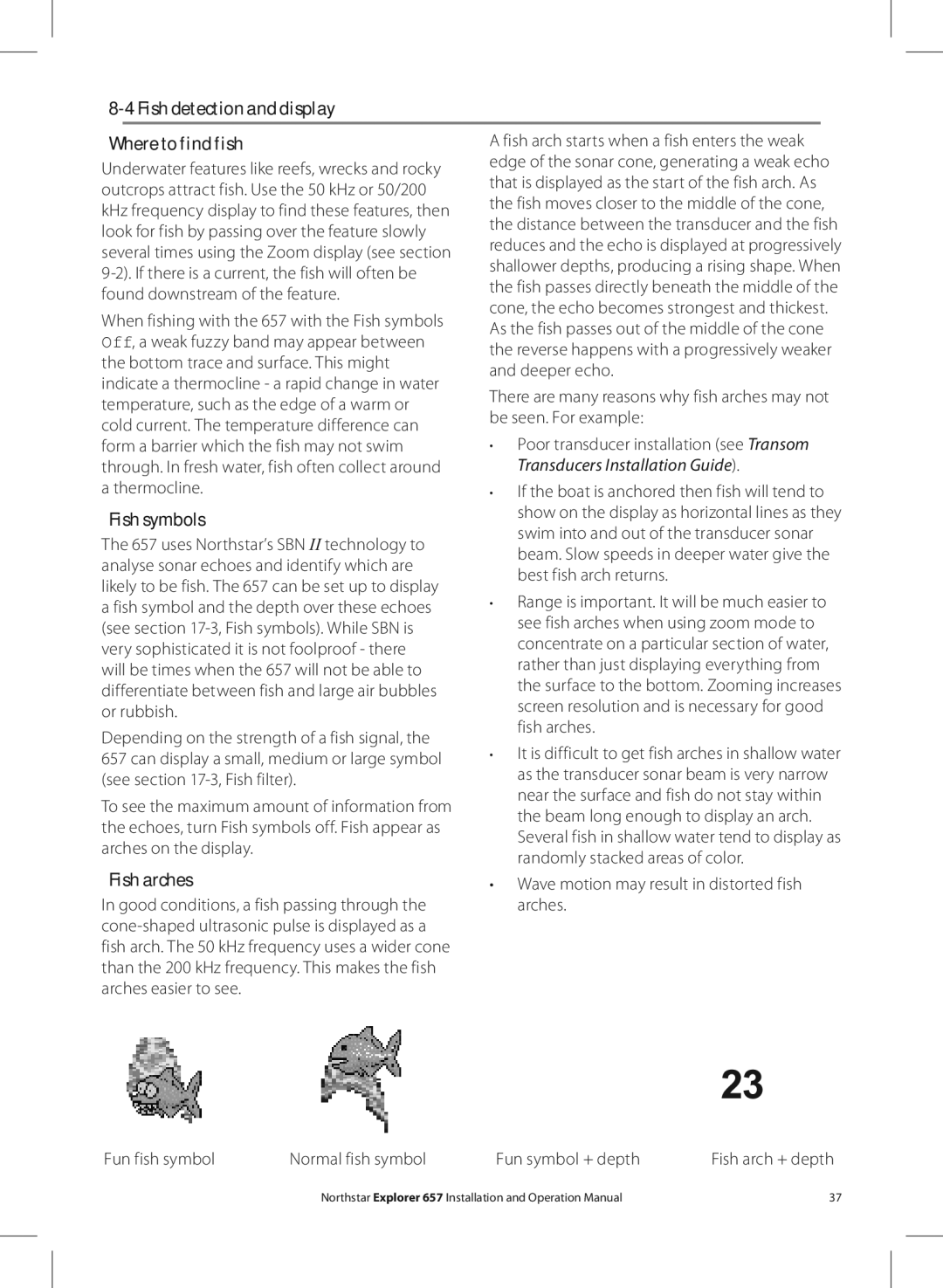
8-4 Fish detection and display
Where to find fish | A fish arch starts when a fish enters the weak | |
Underwater features like reefs, wrecks and rocky | edge of the sonar cone, generating a weak echo | |
that is displayed as the start of the fish arch. As | ||
outcrops attract fish. Use the 50 kHz or 50/200 | ||
the fish moves closer to the middle of the cone, | ||
kHz frequency display to find these features, then | ||
the distance between the transducer and the fish | ||
look for fish by passing over the feature slowly | ||
reduces and the echo is displayed at progressively | ||
several times using the Zoom display (see section | ||
shallower depths, producing a rising shape. When | ||
the fish passes directly beneath the middle of the | ||
found downstream of the feature. | ||
cone, the echo becomes strongest and thickest. | ||
When fishing with the 657 with the Fish symbols | ||
As the fish passes out of the middle of the cone | ||
Off, a weak fuzzy band may appear between | ||
the reverse happens with a progressively weaker | ||
the bottom trace and surface. This might | and deeper echo. | |
indicate a thermocline - a rapid change in water | ||
There are many reasons why fish arches may not | ||
temperature, such as the edge of a warm or | ||
be seen. For example: | ||
cold current. The temperature difference can | ||
• Poor transducer installation (see Transom | ||
form a barrier which the fish may not swim | ||
through. In fresh water, fish often collect around | Transducers Installation Guide). | |
a thermocline. | • If the boat is anchored then fish will tend to | |
Fish symbols | show on the display as horizontal lines as they | |
The 657 uses Northstar’s SBN II technology to | swim into and out of the transducer sonar | |
beam. Slow speeds in deeper water give the | ||
analyse sonar echoes and identify which are | ||
best fish arch returns. | ||
likely to be fish. The 657 can be set up to display | ||
• Range is important. It will be much easier to | ||
a fish symbol and the depth over these echoes | ||
see fish arches when using zoom mode to | ||
(see section | ||
concentrate on a particular section of water, | ||
very sophisticated it is not foolproof - there | ||
rather than just displaying everything from | ||
will be times when the 657 will not be able to | ||
the surface to the bottom. Zooming increases | ||
differentiate between fish and large air bubbles | ||
screen resolution and is necessary for good | ||
or rubbish. | ||
fish arches. | ||
Depending on the strength of a fish signal, the | ||
• It is difficult to get fish arches in shallow water | ||
657 can display a small, medium or large symbol | ||
as the transducer sonar beam is very narrow | ||
(see section | ||
near the surface and fish do not stay within | ||
To see the maximum amount of information from | ||
the beam long enough to display an arch. | ||
the echoes, turn Fish symbols off. Fish appear as | ||
Several fish in shallow water tend to display as | ||
arches on the display. | ||
randomly stacked areas of color. | ||
Fish arches | ||
• Wave motion may result in distorted fish | ||
In good conditions, a fish passing through the | arches. | |
| ||
fish arch. The 50 kHz frequency uses a wider cone |
| |
than the 200 kHz frequency. This makes the fish |
| |
arches easier to see. |
|
Fun fish symbol | Normal fish symbol | Fun symbol + depth | Fish arch + depth |
Northstar Explorer 657 Installation and Operation Manual | 37 |
